Space art and culture in Brazil: Three years of activities at the National Institute for Space Research (2/2)
Published 15 September 2022 by Fabiane M. Borges
Since 2019, Fabiane M. Borges curates a research platform on Art and Space Culture at the Brazilian National Institute for Space Research (INPE). On the occasion of the 73d International Astronautical Congress in Paris, the Space Without Rockets publication and the Global Periphery symposium, she comes back on the last three years of the program. Second part.
Workshops of ArtSat (PGETE/INPE – 2020/2021)
ArtSat as a new category of CubeDesign has opened a new demand for our space art and culture program: to build an ArtSat development workshop, even to guarantee that there will be Brazilian participation in CubeDesign competitions and other satellite competitions. But it is not only about teaching how to build a technical object in the form of an artistic satellite. It is also about creating a conceptual work that enlarges the cultural spectrum that involves the artifact, giving conditions for a wide range of possibilities, based on global historical references, geopolitical and astropolitical discussions related to both art and space science, fomenting debates about space law, contemporary art, international circuit of art and technology, economic systems behind satellite technology, and so on. We apply the criteria developed in our curatorial line to make critical, political, ethical, ecological, philosophical and aesthetic thinking flourish. Our mission is to further the flourishing of transdisciplinary languages, to enhance the creativity of the workshops by bringing in experienced guests to talk about their projects, coordinators of space science institutes, curators from various countries, organizers of art and technology festivals, and artists who have already sent works into space.
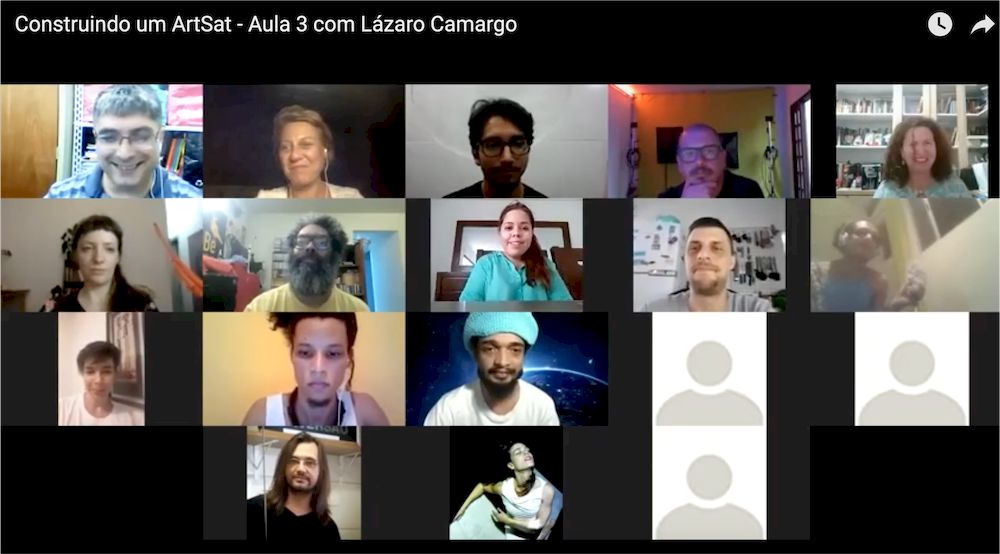
The II Workshop of ArtSat / 2020 encouraged greater participation from the Latin American public. The reason is obvious: We share similar interests and difficulties. It serves as a socio-technological investment in regional Space Culture, which seeks above all to bring together the common interests of various groups from different countries in order to foster the production of a singular space art-science, which does not submit indiscriminately to the polarizing discourses of the great space programs, or the great Art and Science programs, which centralize financial and media resources overshadowing the initiatives of developing countries. If we enter the new Space Race bringing with freedom a Latin, tropical space culture, producing the equatorial perspectivist technodiversity, won’t we be contributing more effectively to the international community? In other words, there are discursive and technological components that are unique and non-transferable from their local value, that can be of great value to the world. However, conditions must be created to facilitate these characteristics to appear.
Latin America needs to develop research, technoscientific production and a singular space art/culture, that express its geopolitical condition, with its emerging, indigenized, africanized, miscegenated countries, to be capable of creating from its own complexity. The Workshops of ArtSat have a mission to encourage technodiversity. This represents an advance for the thought and production of Latin American art and science, because we want to cooperate in the formation of people that understands the place that Latin American countries occupy in contemporary astropolitics and should occupy in the next steps of the new space race.
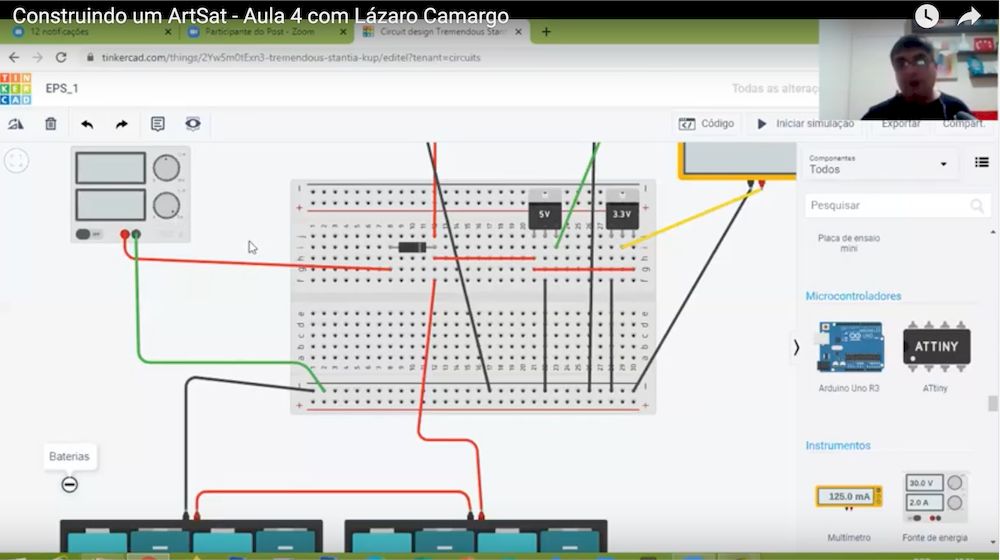
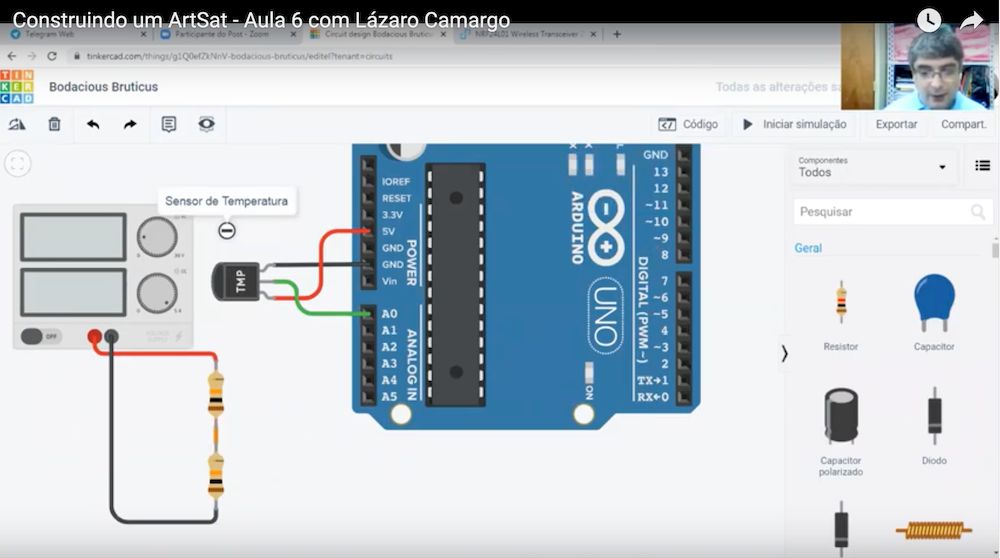
Workshop of ArtSat at INPE / 2020 (13)
The I Workshop of ArtSat at INPE was a 40 hours course focused on art and space culture, organized as follows: 1) workshop for building satellites (ArtSat), executed by the electronic engineer Lázaro Camargo, and 2) presentation of artistic and theoretical works about the art/space science theme, curated by the author of this text, which had the participation of Italo Pinto Rodrigues representing CubeDesign. It had about thirty-five presentations of artistic and scientific research with guests from various places of Brazil and the world (14). In the end four teams were formed (15): 1) Team Antigenik Lab y Navalha Sat by Urutau Maria Pinto y “Antigenik Lab”, 2) Team Caipora-Sat by Alejandra Carolina Labarca Puelles, Ada Grecia Arenas sanchez and Yeté Abunã Marques Labarca, 3) Team ART. Rocket / SOLARSCAPES by Carolina Mattos Schundt, Ricardo Palmieri and Victor Valentim, 4) Team Inumeráveis / Livro da Vida – a memorial pocketQube – by Edson Pavoni, Pedro Kaled and Roberta Savian. The latter participated in the CubeDesign competition in the ArtSat category and took first place, and now in September 2022 launches its ArtSat into space, through Space X.
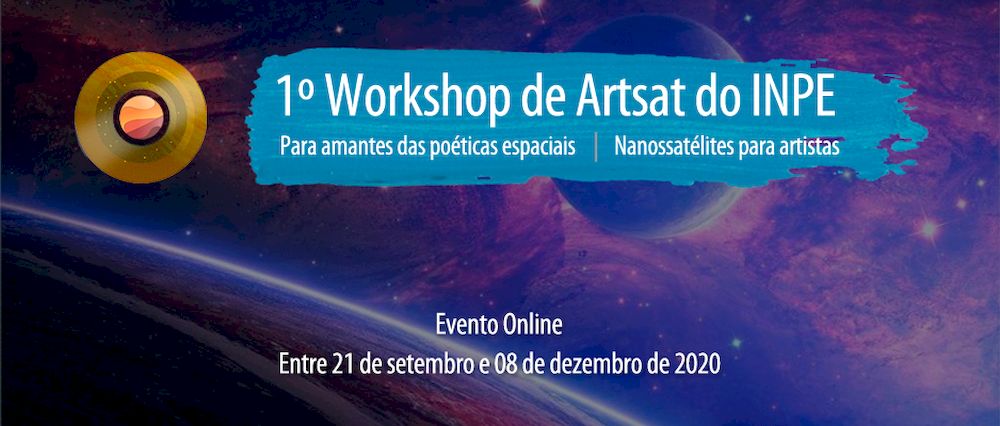
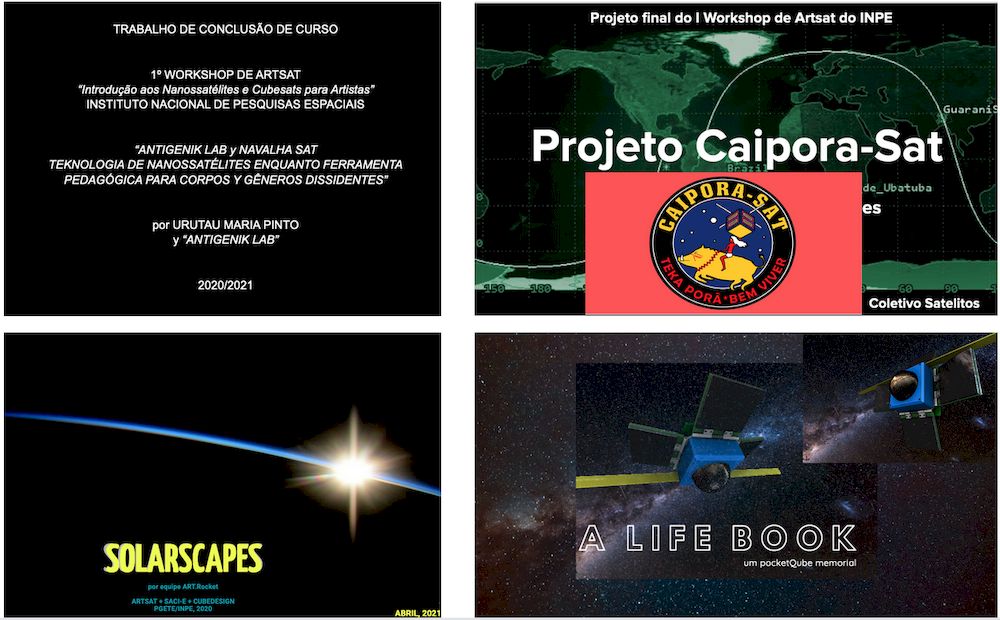
Workshop of ArtSat at INPE / 2021 (16)
The II Workshop of ArtSat at INPE, as the first workshop, was a 40-hour course focused on space art and culture, organized as follows: 1) workshop for the construction of satellites (ArtSat), executed by the electronic engineer Lázaro Camargo and 2) Presentation of artistic and theoretical works on the theme of art/space science, under the curatorship of the author of this text, which had about 10 theoretical debates (17) from the Latin American perspective, with guest speakers from countries such as Mexico, Ecuador, Colombia, Chile, Bolivia and from Brazilian states such as Amazonas, Pará, Rio Grande do Norte and São Paulo. 3) An open call for the creation of an album of space music, made only for Latin American musicians. In the end a single cross-disciplinary team with 10 members called ARATUSAT. Aratu means a mangrove crab, which is used in the project as a reference to the manguebit movement that brings together Pernambuco’s regional culture with electronic music, plus aspects critical to globalization. ArtSat’s mission is to create a model for reading space debris and transform them into artistic readings, but with the data released. The team consists of 10 members: Arad Walsh, Enzo Garabito, Fernanda Neves, Isabella Fernanda, Lino Divas, Luciana de Paula Santos, Núbia de Moura Borges, Pitter Gabriel Maciel Rocha, Sidney Monteiro Jr. For those who want to get to know the project, access the SACI-E website (18).

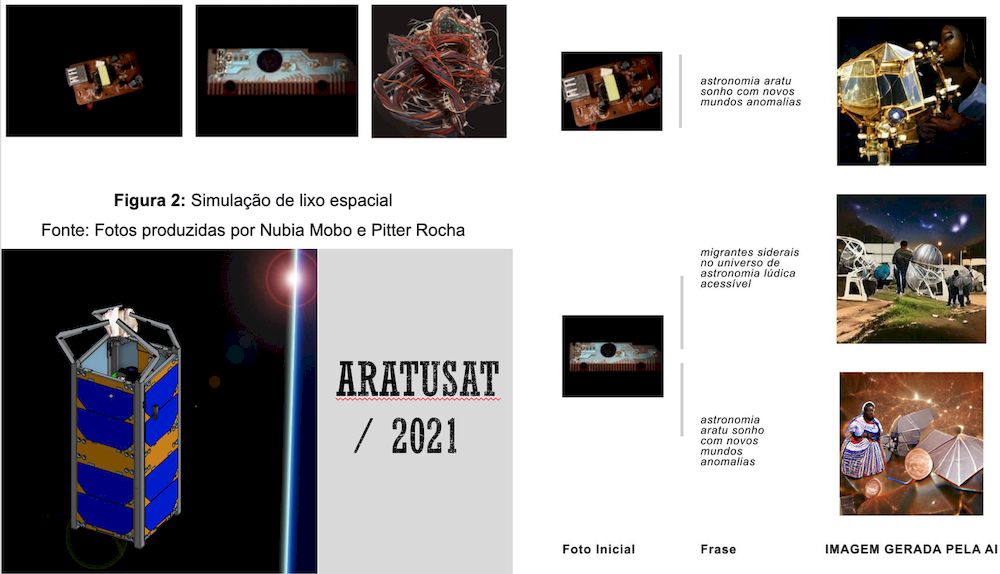
First Album of Latin American Cosmic Sounds (19)
We took advantage of the structure of the II ArtSat Workshop at INPE to launch an open call for the creation of the First Album of Latin American Cosmic Sounds. It was focused entirely on Latin American musical artists. The main theme of the album was “Latin America in the future of space occupations”. The theme gave us the opportunity to contribute to the construction of an imaginary spatial sound repertoire, gathering practices and poetics that represent the diversity of sound production and the local specificities of some Latin American countries. Compositions that explore the relationship between scientific data and sonification were considered in the Album. This data could be extracted from artifacts such as satellites, probes, antennas, telescopes, remote sensing techniques or other space equipment from any country, or from previously produced sound materials. Data and image sonification, electromagnetic interferences, programming, computer engineering, circuit-bending, arduino, scores and graphic notations were used in the compositions. We emphasized that the sound proposal should relate technique, concept and poetics, articulating the material with the theme of the album and with the issues surrounding environmental and climate changes, atmospheric pollution and spatial occupation.
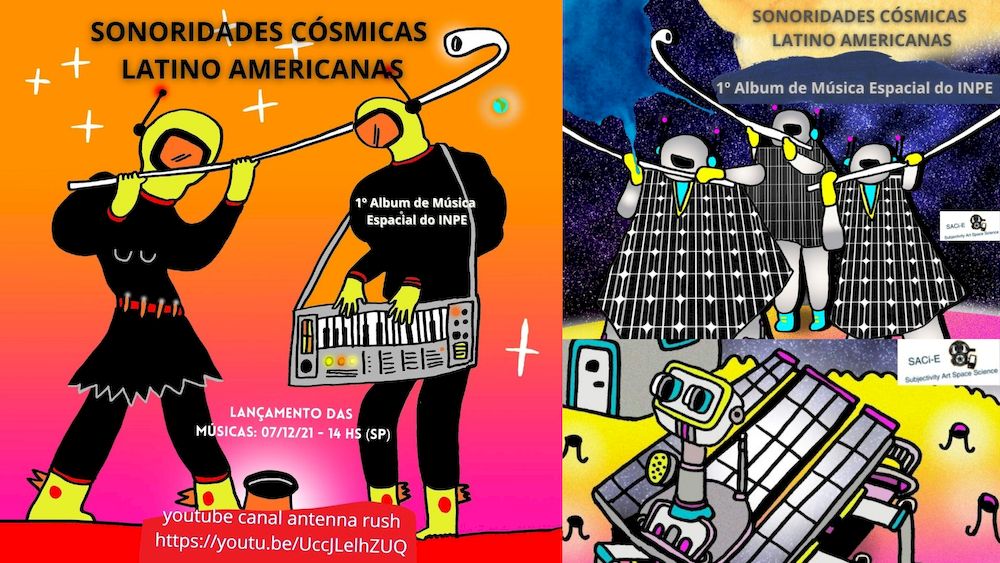
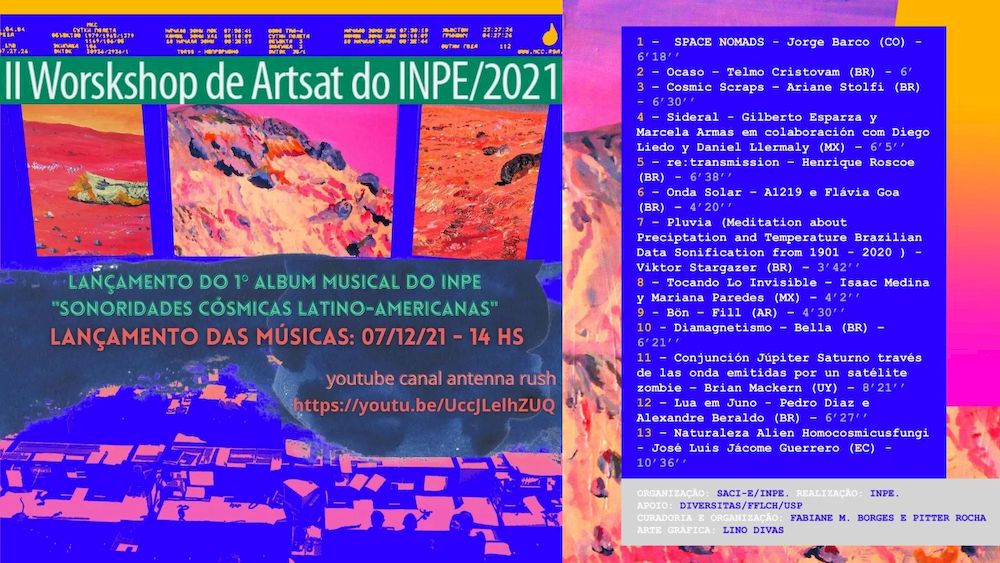
“The collection covers different practices and techniques of sound creation, such as electroacoustic and noise music, sound collage, field recording, different approaches to sonification of data and images, improvisation, creation of instruments to capture electromagnetic waves that are converted into sound. The set instigates by presenting a diverse aesthetic picture of sound speculations of the cosmos through the sound memory of space missions, records of electromagnetic manifestations, sonification of scientific data from space program archives, solar activity and rain flow. The compilation is a cosmic cross between art, science, technology, speculative fiction, and sound. This mix activates the listener’s cosmoperception to the vibrations of the invisible, the noise that runs through us. The cosmic sonorities are a journey where we embark on a nomadic experience through space enveloped by one of the engines. They make us feel the warmth of the electromagnetic waves of solar winds in the glowing sunset, which burn away the remnants of the expanded voices of human experience. The sidereal sonic experience is a continuum from the silence of the vacuum to the subtle vibration of the meteor, the life force, the axé of the celestial body. It relays, re-reads, revises, reactivates the imagery and imagination of the dimensions and forces of Space; it sonifies the vision of science and allows us to read images in their smallest parts, bits, pixels and frames, creating movement. Thus, we dance solar data in Afro-indigenous Atlantic beats and revisit the first science, the science of rhythm, the one that shapes time. The effect of time is fluid, it dilates and contracts, flows like the waters in 100 years within 3 minutes. Sound, as the ontology of a world, allows us to touch the invisible, greet the sub-atomic, and echo into eternity, aligned with the stars, undead satellites, and alien nature (20).
For the realization of the album we invited the brazilian artist, musician and second artistic resident of INPE, Pitter Rocha, to share the curatorship with the author of this text, and the Argentinean artist Lino Divas to do the graphic design. The album Latin American Cosmic Sonorities brings together 13 sound compositions by 19 artist-scientists from 6 countries (Argentina, Brazil, Colombia, Ecuador, Mexico, and Uruguay). Its purpose was to deflate the Latin American imaginary about the cosmos, thus constituting a spatial sound occupation allied to the multiplicity of cultures and musical styles of this group of countries. The selection was made through an open call, with the following provocations: What is the role of Latin America in Space Occupations? What contribution can it make to global space thinking from its specific singularity? The album is the result of these provocations. The tracks were chosen through curation and two guest jurors: Tatiana Cuoco (Argentina) and María Ignacia Edwards (Chile).
List of artists and the songs of the Album of Latin American Cosmic Sounds
1 – SPACE NOMADS – Jorge Barco (CO) – 6’18”
2- Ocaso – Telmo Cristovam (BR) – 6”
3- Cosmic Scraps – Ariane Stolfi (BR) – 6’30”
4 – Sideral – Gilberto Esparza and Marcela Armas in collaboration with Diego Liedo and Daniel Llermaly (MX) – 6’5”
5 – re:transmission – Henrique Roscoe (BR) – 6’38”’
6 – Solar Wave – A1219 and Flávia Goa (BR) – 2021, 4’20”
7 – Pluvia (Meditation about Precipitation and Temperature Brazilian Data Sonification from 1901 – 2020 ) – Viktor Stargazer (BR) – 3’42”
8 – Tocando Lo Invisible – Isaac Medina y Mariana Paredes (MX) – 4’2”
9 – Bön – Fill (AR) – 4’30”’
10 – Diamagnetism – Bella (BR) – 6’21”’
11 – Jupiter Saturn conjunction through the waves emitted by a zombie satellite – Brian Mackern (UY) – 8’21”’
12 – Moon in Juno – Pedro Diaz and Alexandre Beraldo (BR) – 6’27”
13 – Naturaleza Alien Homocosmicusfungi – José Luis Jácome Guerrero (EC) – 10’36”’
Plutocracy on Pluto, summer course focused on astropolitics (21)
Plutocracy is a system of government where only the wealthy have the legal right to exercise political control. It is a regime where the class that dominates the means of production, circulation, and distribution of wealth is the same class that determines the fate of the earthly populations. An example of this is the operating model of the technology corporations known as Big Techs, which spread across all continents of the planet determining social relations and using as capital, user data on a global level. When we talk about Plutocracy on Pluto we are making a double provocation, which is to question the forms of power and control on Earth and also in Space. We ask ourselves whether the worldviews that are at stake in the New Space Race, with all its projects for military weaponry, production of space technology, artificial intelligence and mining of celestial bodies (such as the Moon, Mars and asteroids) will serve only to empower the plutocracy from the acceleration of the modes of domination of the solar system by a few corporate conglomerates, or whether we are facing a new possibility of creating a future that will also allow the transportation of the multiplicity of world views, different perspectives of the world and biodiversity that characterizes, in principle, the planet Earth. In other words, through this new space opportunity, will collaboration between peoples be more determining than competition between large corporations, or are we only reinforcing with more sophisticated models the hierarchy and discrepancy between rich and poor peoples? Plutocracy on Pluto was a course in astropolitics, geopolitical positioning, that helped us map out the interests behind current space projects, be they military, industrial, commercial, or scientific. It is also a study of the imaginaries that cross this new frontier. We want to zoom in on the utopias, dystopias, philosophical, speculative, artistic imaginaries, and on the science fictions that have been produced by means of this space dilemma, to better visualize the aesthetics of the future that are being produced in this context of climate change and space occupation.
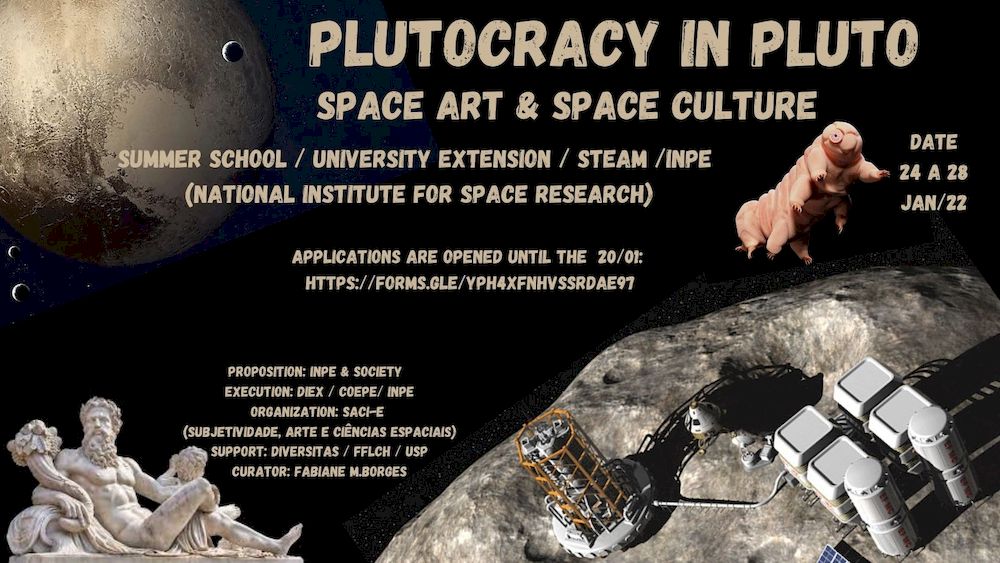
Plutocracy on Pluto was a geopolitics course focused on space issues. It was held from January 24 to 28, 2022, in a virtual form, with intensive meetings in the mornings and afternoons. The course dealt with political issues, economic and legal multilateral interests of the state and private sectors that configure the “new space”. From the perspective of art and space culture, topics such as colonies on the Moon and Mars, mining the celestial stars, utopias and dystopias of space programs, and the subjective constructs that accompany such themes were addressed. Futuristic and aesthetic imaginaries were brought through the point of view of curators, philosophers, entrepreneurs, artists, scientists, natives, astronomers, engineers, and others. We consider the knowledge of geopolitics to be extremely important for training in the sectors of space art and culture, so that students can understand space projects in depth and be able to evaluate the forces at play in the current process of expansion towards the solar system. In all, there were 18 specialists in the fields of space art, science, and technology, with about 90 students enrolled. We consider the course to be excellent because of its boldness and creativity. Working with such complex themes as space geopolitics in a transdisciplinary way and with the bias of the great philosophical sets that guide the space art and culture places this course in the international state of the art. The quality of the lectures, the multiculturalism of the speakers, the perspective of the global south in the face of the whole New Space scene, the depth with which the themes were discussed and the attention given by the registrants makes us consider the course worthy of continuation.
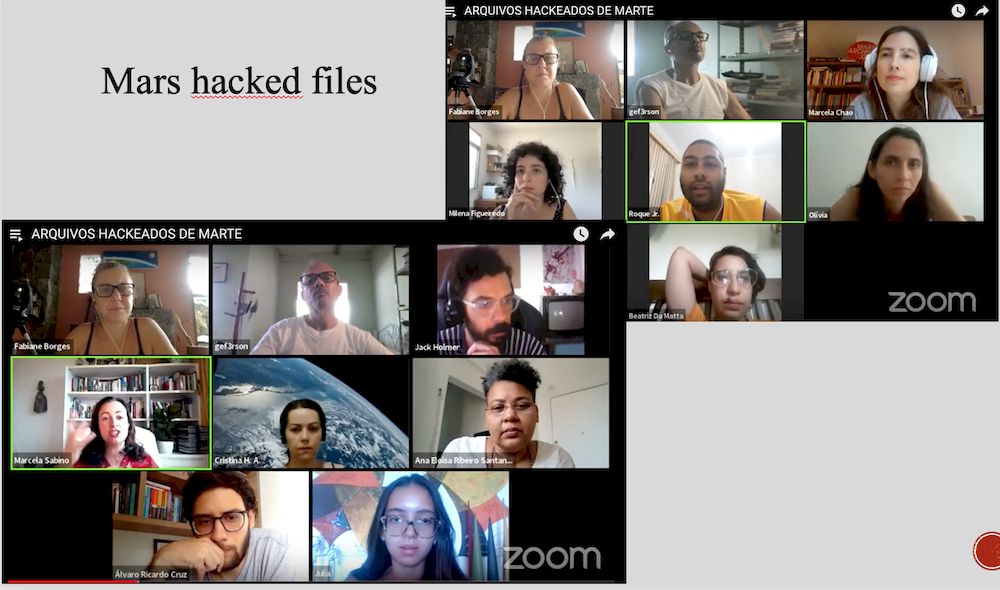
Conclusion
In terms of comparison with other international space programs, we deduce that the four projects developed at INPE so far are in line with the state of the art in the area of space art and culture. We consider this projects innovative and excellent in terms of results, shared technologies and conceputalization. The projects are complying with the curatorial line to which we propose ourselves that seeks originality, authenticity and cultural diversity. Para comprovar isso, usamos como exemplo os trabalhos finais das oficinas ArtSats, que, além de serem feitas por meio de equipes transdisciplinares que se organizam dentro da própria oficina, trazem em sua missão, propostas que condizem com a linha curatorial do nosso programa, como como o CaiporaSat/2020, que como projeto pretende trabalhar com sensoriamento remoto em regiões de reservas indígenas, ou o NavalhaSat/2020, que apesar de ainda não ter desenvolvido totalmente o satélite, tem uma equipe formada apenas por travestis, ou o AratuSat/2021 que é baseado no ancestrofuturismo (ancestralidade e imaginações futurísticas) trazendo como missão do ArtSat registrar dados e imagens de lixo espacial da baixa órbita terrestre (LEO – Low Earth Orbit) para produzir trabalhos com esses dados de arte e exibi-los, realizando assim apropriações e reconfigurações, na tentativa de sensibilizar e aproximar as pessoas de uma questão tão urgente que é o lixo espacial. With these few examples we can verify that there is a correspondence between the curatorial interests and the production of ArtSats, and this means that we are opening a significant transdisciplinary line.
Finally, we emphasize that the developed projects can be replicated and deepened to the extent that they have more institutional support both in terms of internal and external recognition of INPE, which can only happen through dissemination, translation, publication and exchanges. In 2022 and 2023, both the ArtSat Workshop, the summer course and the record production could be part of the Space Studies Program (SSP) of the International Space University (ISU), which may come to be held in Brazil under the coordination of INPE, the Instituto Tecnológico de Aeronáutica (ITA) and the Prefeitura de São José dos Campos. It is also possible to be presented in international meetings such as the ITACCUS / IAF (Committee for the Cultural Utilization of Space of the International Astronautical Federation), besides being possible to start a series of exchanges with research centers in art and space culture in countries of Europe, North America, India, Russia and China, research centers in Latin America and countries of the Global South.
Read first part of the report.
Space Without Rockets, ed. Rob La Frenais, Ewen Chardronnet, UV Editions, August 2022.
Global Periphery, Contemporary Imaginaries of Space, Multiple Voices – A Hybrid Conference. September 23-24 at Cité internationale des arts, Paris. Global Periphery is organised by Leonardo/Olats and part of More-Than-Planet (2022-2025), co-funded by the Creative Europe program of the European Union.
Disclaimer: This is the perspective adopted by researcher Fabiane M. Borges during the period in which she worked in the implementation of art and space culture projects at INPE, but this narrative is personal and does not represent the National Institute of Space Research or the current Federal Government of Brazil.
